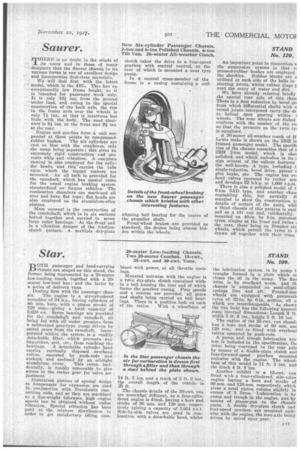Saurer.
Page 165

If you've noticed an error in this article please click here to report it so we can fix it.
THERE is no doubt in the minds of its users and in those of many designers that the Saurer chassis in its various forms is one of excellent design and incorporates first-class materials.
We will deal first with the latest model, which is the 413L. This has an exceptionally low frame height, as it is intended for passenger work only. It is only 164 ins, from the ground under load, and owing to the special construction of the back axle, the rise in the frame arch over the wheels is only 74 ins., so that it interferes but little with the body. The road clearance is Si ins, at the front and 94 ins. at the rear.
Engine and gearbox form a unit suspended at three points by compressedrubber bushes. The six cylinders are cast en bloc with the crankcase, only the sump being separate ; this gives an extremely rigid construction and prevents whip and vibration. A one-piece casting is also employed for the cylirder heads, and this carries the tube upon which the tappet rockers are mounted. An oil bath is provided for the camshaft, which has special cams for the usual engine braking system standardized on Sauer vehicles. The combustion chambers are machined all over and have flat tops; flat heads are also employed on the aluminium-alloy pistons.
Most unusual is the construction of the crankshaft, which is in six sections bolted together and carried in seven large roller bearings. At the front end is a vibration damper of the frictionclutch pattern. A. multiple dry-plate
clutch takes the drive to a four-speed gearbox with central control, at the rear of which is mounted a neat tyre pump.
In a central cross-member of the frame is a casing containing a self aligning ball bearing for the centre of the propeller shaft.
Front-wheel brakes are provided as standard, the drums being almost hidden within the wheels.
An important point in connection NA the suspension system is that ci pressed-rubber bushes are employed the shackles. Rubber blocks are a utilized at each side of the balls in steering joints, whilst rubber rings ii vent the entry of water and dirt.
We have already referred briefly the special rear axle of this chas There is a first reduction by bevel ge from which differential shafts with u versal joints interposed carry the dr to helical spur gearing within I wheels. The rear wheels are dished conform with the camber of the so: so that the pressure on the twin tyl is eqnalized.
A 26-seater all-weather coach of H Lewis make is shown on the 3BH lo framed passenger model. The specifi( tion of the chassis resembles that of t 2BH 2-ton model, which is shos polished, and which embodies in its ( sign several of the salient features the well-known A type, including t single-reduction bevel drive, patent e ,gine brake, etc. The engine has ov( head valves operated by rocker mu and develops 52 b.h.p. at 1,600 r.p.rn. There is also a polished model of t. 0-ton SAD type, and another elms: resembling this, but partially di mantled to show the construction ai details of certain of the units, ',AA a third chassis of this pattern is equi Ped as a tilt van and, incidentally, mounted on 40-in. by 8-in. pnemnat tyres, singles at the front and twins the rear, these being on Simplex ste wheels, which permit the tyres to drawn off together with their rims.


















































































































































































































































































































